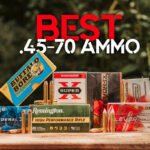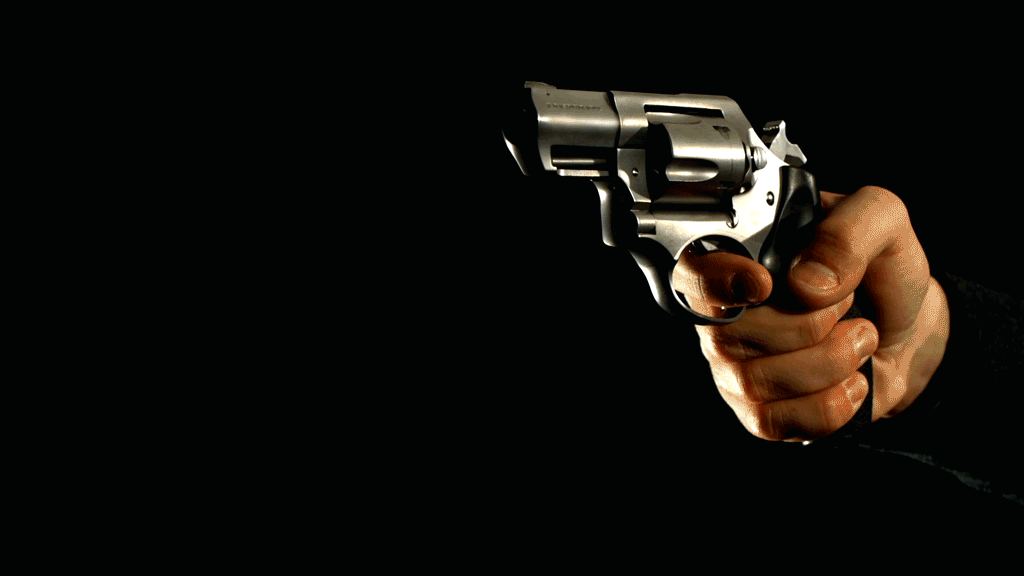
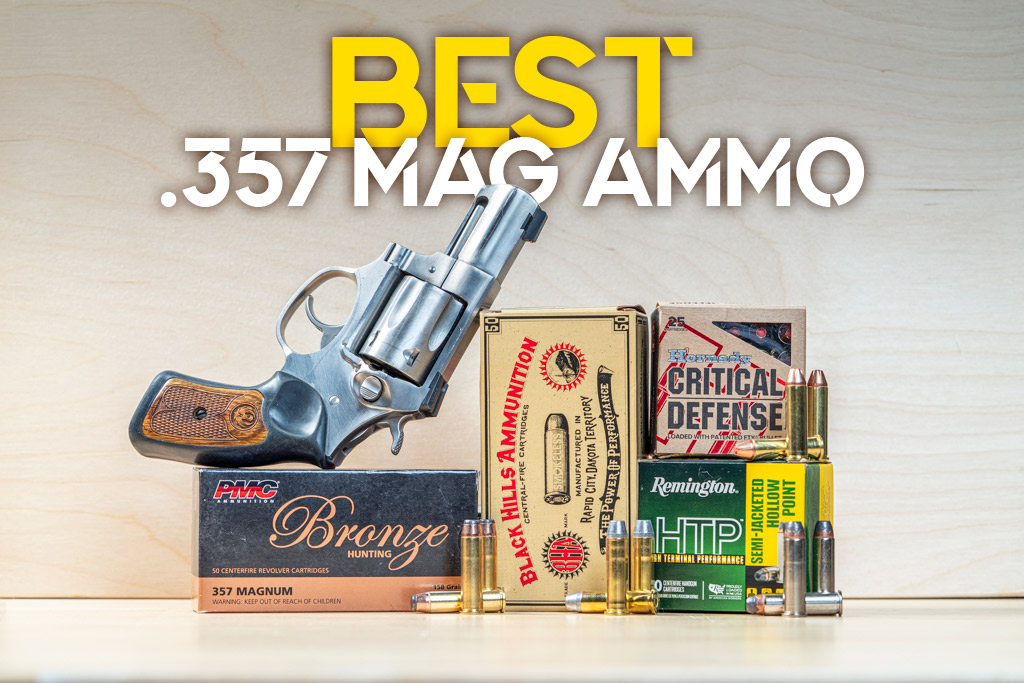
The .357 Magnum is a classic revolver cartridge that has stood the test of time, offering versatility, power, and precision. Whether you’re a seasoned shooter or new to firearms, understanding the nuances of .357 Mag ammo can enhance your shooting experience. This guide delves into the cartridge’s history, specifications, and ballistics and provides insights into selecting the best .357 magnum ammo for various purposes, including a brief comparison with the .38 Special.
The .357 Magnum cartridge is renowned for its balance of manageable recoil, stopping power, and accuracy. Developed in the early 1930s, it has become a staple for law enforcement, hunters, and personal defense. Its adaptability across different shooting disciplines makes it a favorite among enthusiasts and professionals alike.
Best .357 Magnum Ammo – Our Picks
We get lots of questions about the “best” ammo out there. Well, the best ammo depends on what you’re trying to achieve. With that in mind, we’ve provided our picks for the best .357 magnum ammunition for practice, precision shooting, hunting, and home/self-defense. The cartridges that made the cut include:
Best 357 Magnum for Plinking & Training
Armscor 357 Mag 125 Grain FMJ
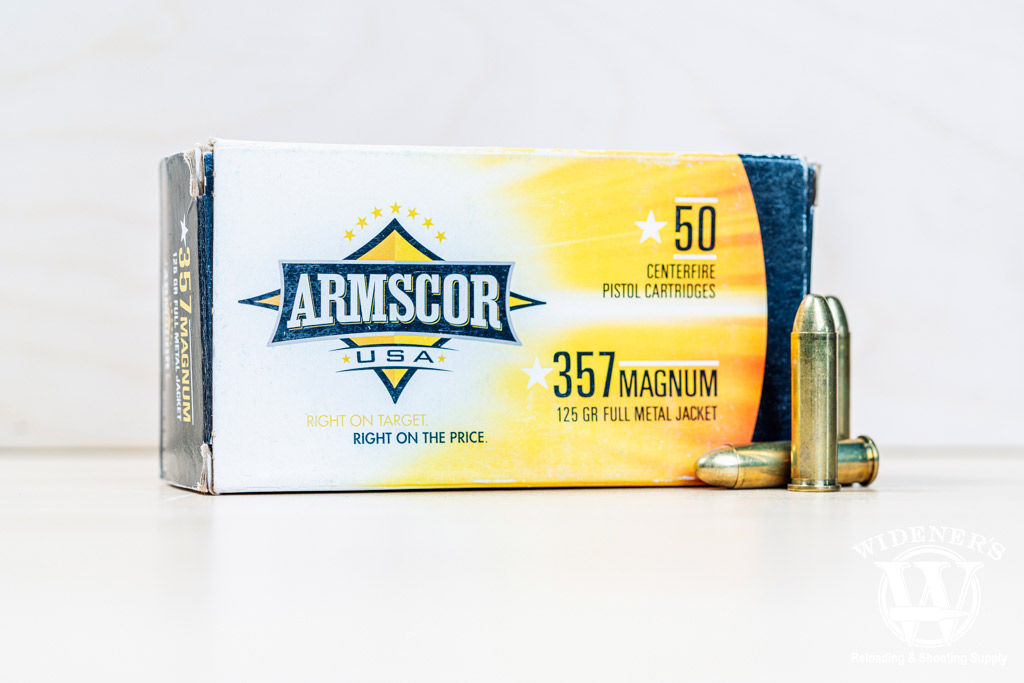
You can’t go wrong buying Armscor 357 Mag 125 Grain FMJ in bulk for training at the range.
Armscor’s 357 Mag 125 Grain FMJ offers reliability and consistency for range shooting and training. It’s a good all-around practice ammo, and it’s priced well. These cartridges have genuine brass casings, which means they can be reloaded.
At just 125 grains, these projectiles are snappier than some of their heavier counterparts. Still, they produce a respectable 936 foot-pounds of muzzle energy and leave the barrel traveling 1,836 feet per second.
| Caliber | Bullet Type | Bullet Weight | Velocity (Muzzle) | Energy (Muzzle) | 25 Yards (Velocity/Energy) | 50 Yards (Velocity/Energy) | 100 Yards (Velocity/Energy) |
|---|---|---|---|---|---|---|---|
| .357 Magnum | FMJ | 125gr | 1,836 FPS | 936 FT LBS | 1,710 FPS/812 FT LBS | 1,576 FPS/689 FT LBS | 1,350 FPS/506 FT LBS |
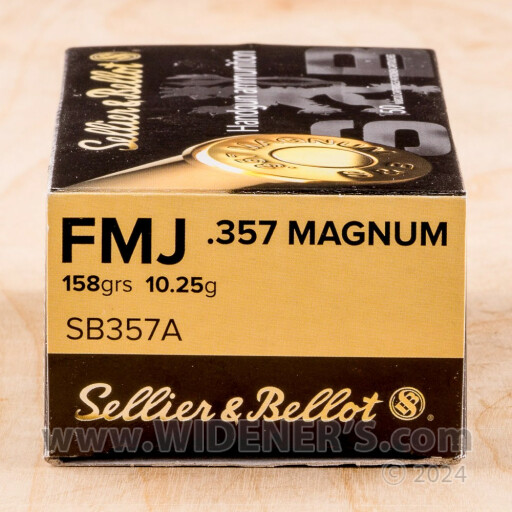
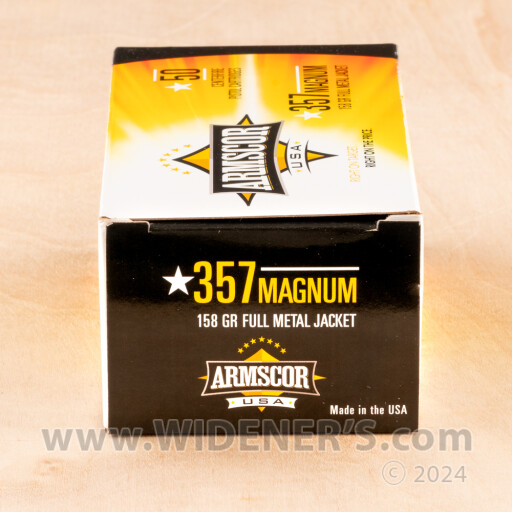
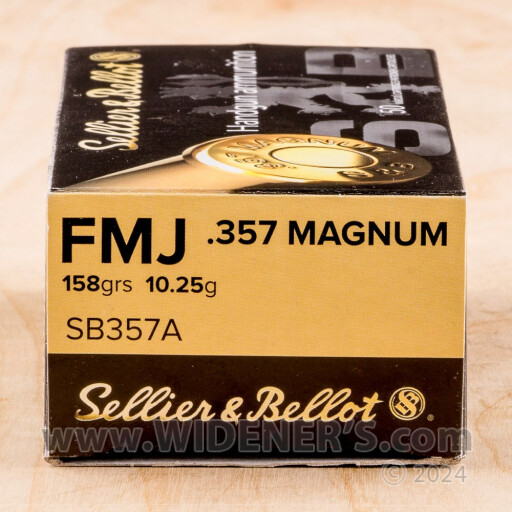
Best 357 Magnum for Cowboy Action Shooting/Match
Black Hills Cowboy Load 357 Magnum 158 Grain
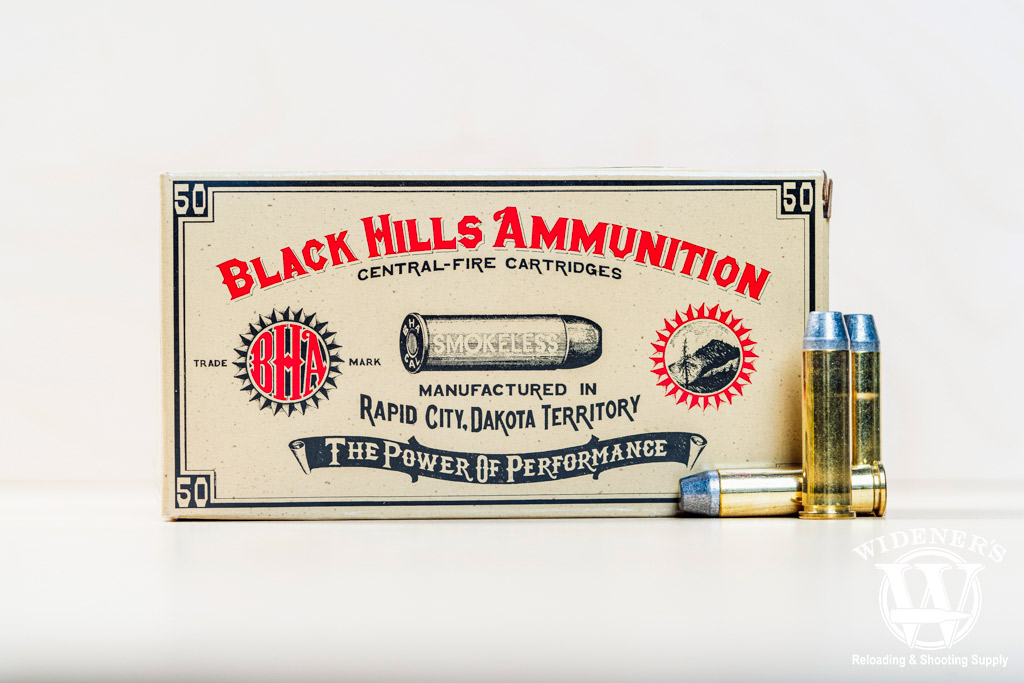
Yee-haw! Grab a box of Black Hills Cowboy Load 357 Magnum for your next Cowboy Action Shoot, partner.
Are you interested in a nostalgic shooting experience that features a period-correct bullet? If so, you’ll love the Black Hills Cowboy 158 grain .357 magnum cartridges. They are tailor-made for Cowboy Action Shooting (CAS) events.
These projectiles feature a period-correct conical-nose lead (CNL) tip. They leave the muzzle at 800 feet per second. While that may sound slow by today’s standards, it is accurate for the period, which is the entire premise behind the Black Hills Cowboy “Authentic Cowboy Action” line.
| Caliber | Bullet Type | Bullet Weight | Velocity (Muzzle) | Energy (Muzzle) | 25 Yards (Velocity/Energy) | 50 Yards (Velocity/Energy) | 100 Yards (Velocity/Energy) |
|---|---|---|---|---|---|---|---|
| .357 Magnum | LRN | 158gr | 800 FPS | 225 FT LBS | 770 FPS/208 FT LBS | 670 FPS/157 FT LBS | 580 FPS/118 FT LBS |
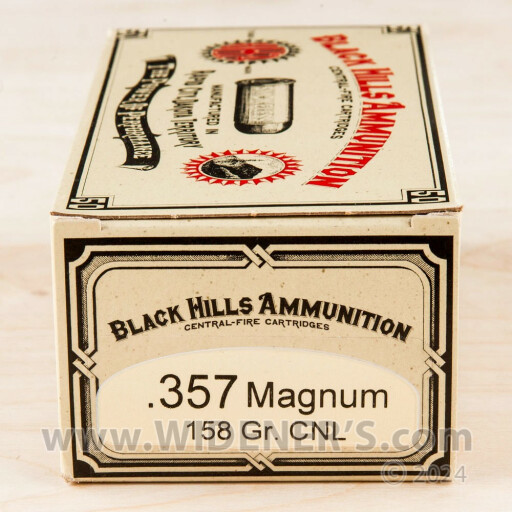
Best 357 Magnum Ammo for Hunting
Remington HTP 357 Magnum 158 Grain SJHP
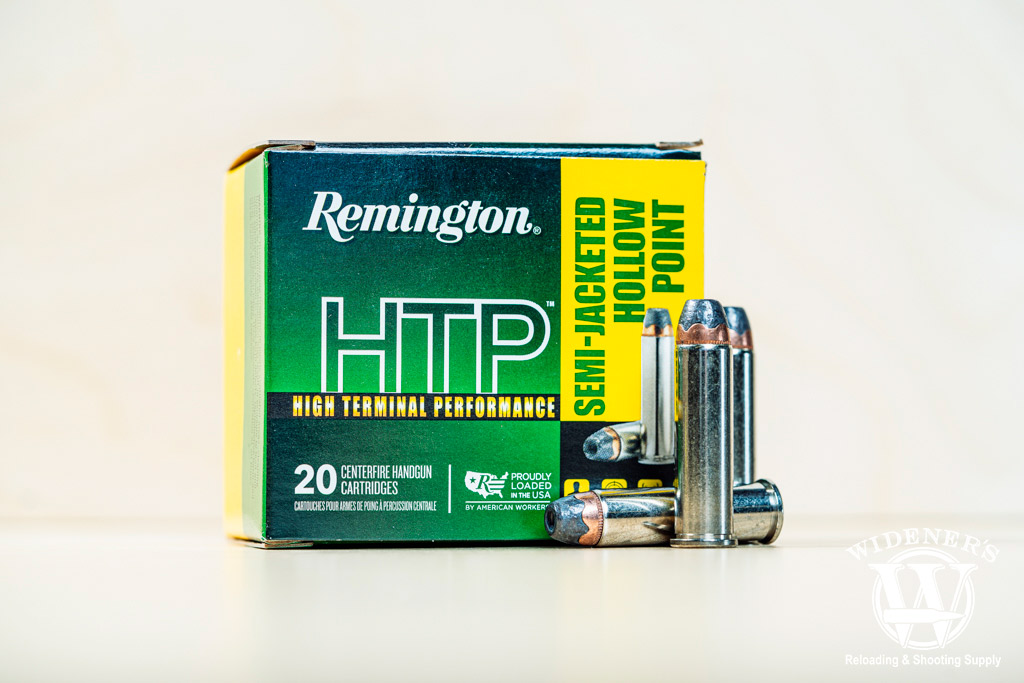
The HTP stands for “High Terminal Performance,” any hunter will tell you Remington’s stopping power is legit.
Regardless of what you’re hunting, it’s always a good idea to carry a capable sidearm. Many hunters like the reliability and simplicity of revolvers, particularly the .357 magnum.
Remington’s high terminal performance soft jacketed hollow points are a great companion for your next hunting trip. They produce a muzzle velocity of 1,235 FPS and 535 foot-pounds of energy at the muzzle.
| Caliber | Bullet Type | Bullet Weight | Velocity (Muzzle) | Energy (Muzzle) | 25 Yards (Velocity/Energy) | 50 Yards (Velocity/Energy) | 100 Yards (Velocity/Energy) |
|---|---|---|---|---|---|---|---|
| .357 Magnum | SJHP | 158gr | 1,235 FPS | 535 FT LBS | 1,164 FPS/475 FT LBS | 1,104 FPS/428 FT LBS | 1,015 FPS/391 FT LBS |
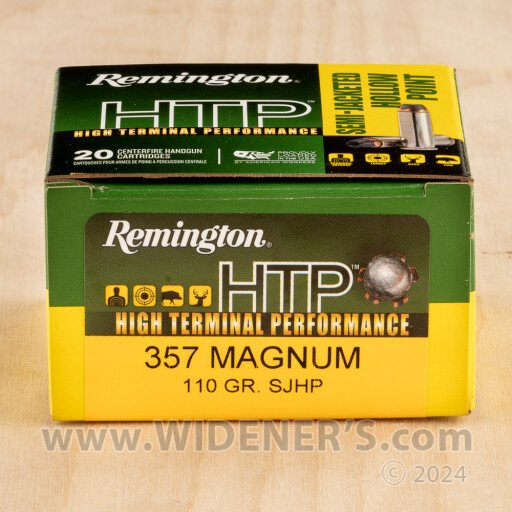

357 Magnum Hunting Choice #2
PMC Bronze 357 Magnum 158 Grain JSP
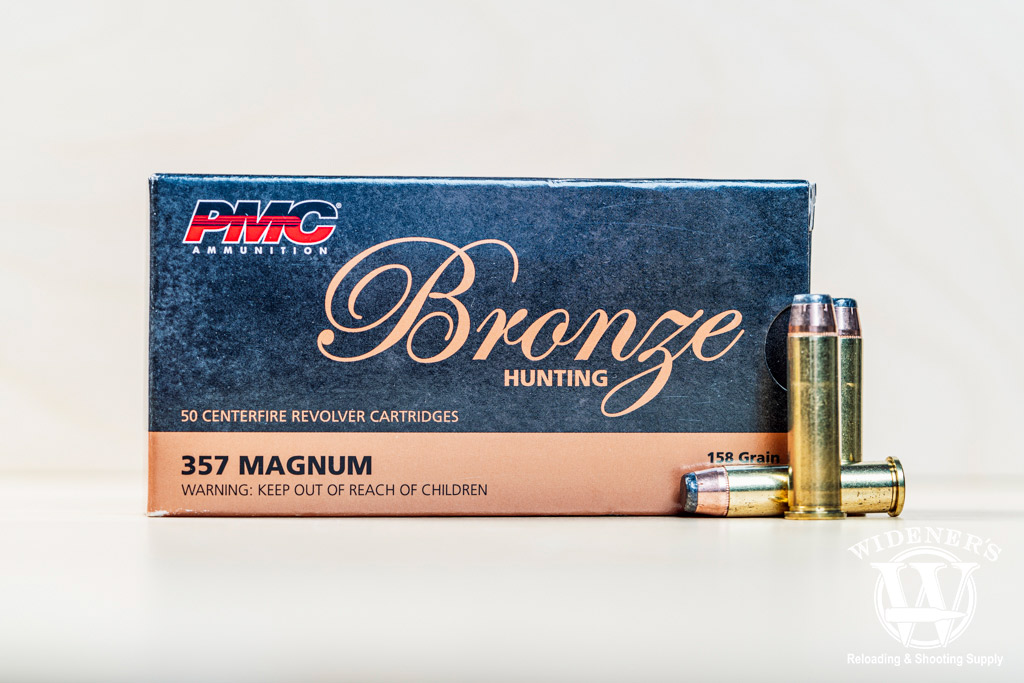
PMC’s Bronze Hunting JHP round has become a staple in many hunter’s seasonal ammo arsenals.
We often get the question, what kind of game can you take with the .357 magnum? Well, deer, antelope, and wild pigs for starters. If you have a predator problem, the .357 is more than powerful enough to drop coyotes, foxes, and depending on where you live, small alligators too.
PMC engineered their Bronze Hunting JHP ammo to accommodate the needs of hunters and varminters alike. They produce a muzzle velocity of 1,471 FPS and 759 foot-pounds of energy at the muzzle.
| Caliber | Bullet Type | Bullet Weight | Velocity (Muzzle) | Energy (Muzzle) | 25 Yards (Velocity/Energy) | 50 Yards (Velocity/Energy) | 100 Yards (Velocity/Energy) |
|---|---|---|---|---|---|---|---|
| .357 Magnum | JSP | 158gr | 1,471 FPS | 759 FT LBS | 1,392 FPS/680 FT LBS | 1,319 FPS/610 FT LBS | 1,192 FPS/498 FT LBS |
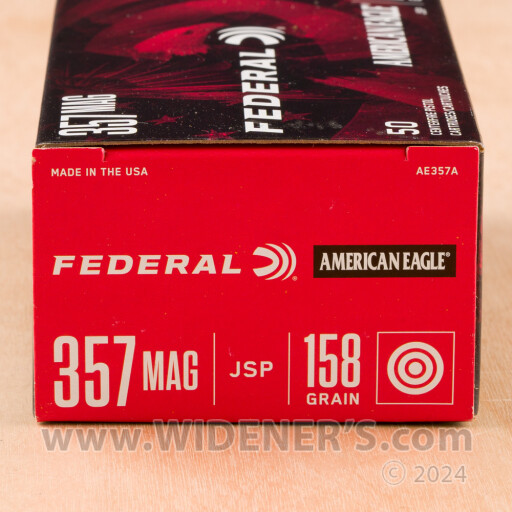

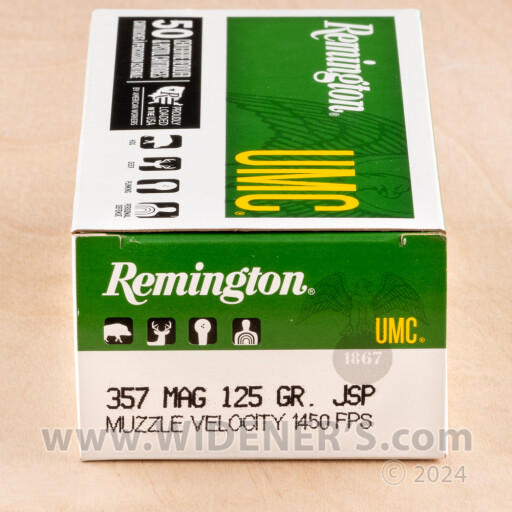
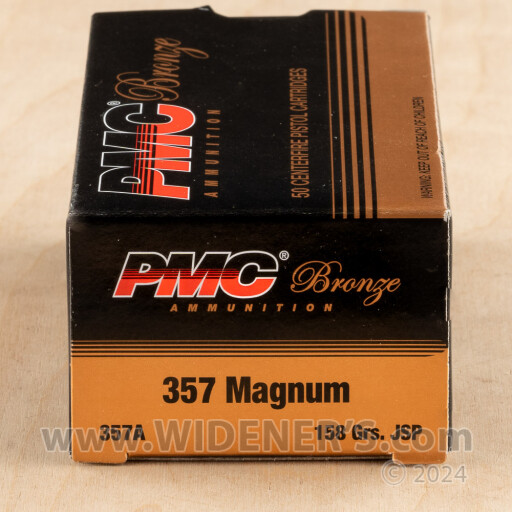
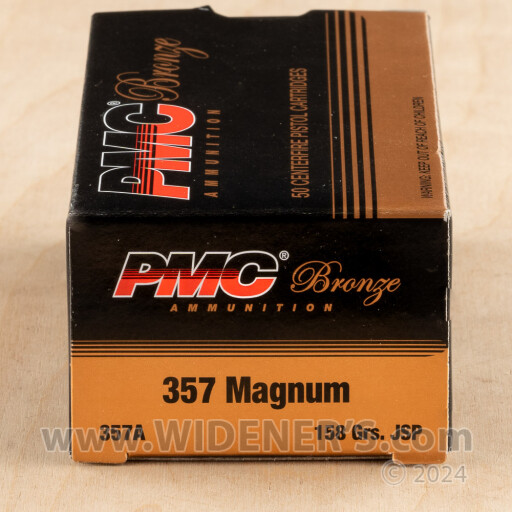
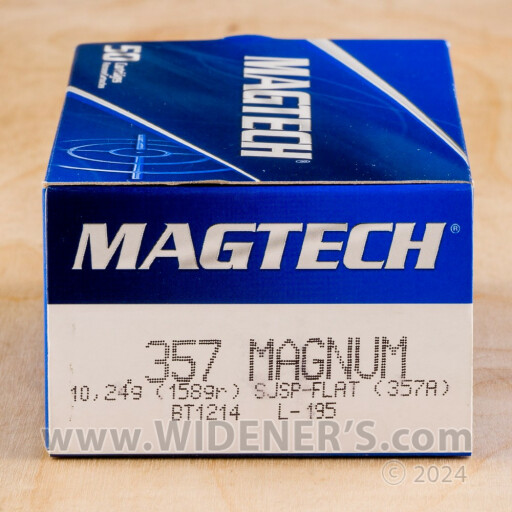

Best 357 Magnum for Self-Defense
Hornady Critical Defense 125 Grain FTX
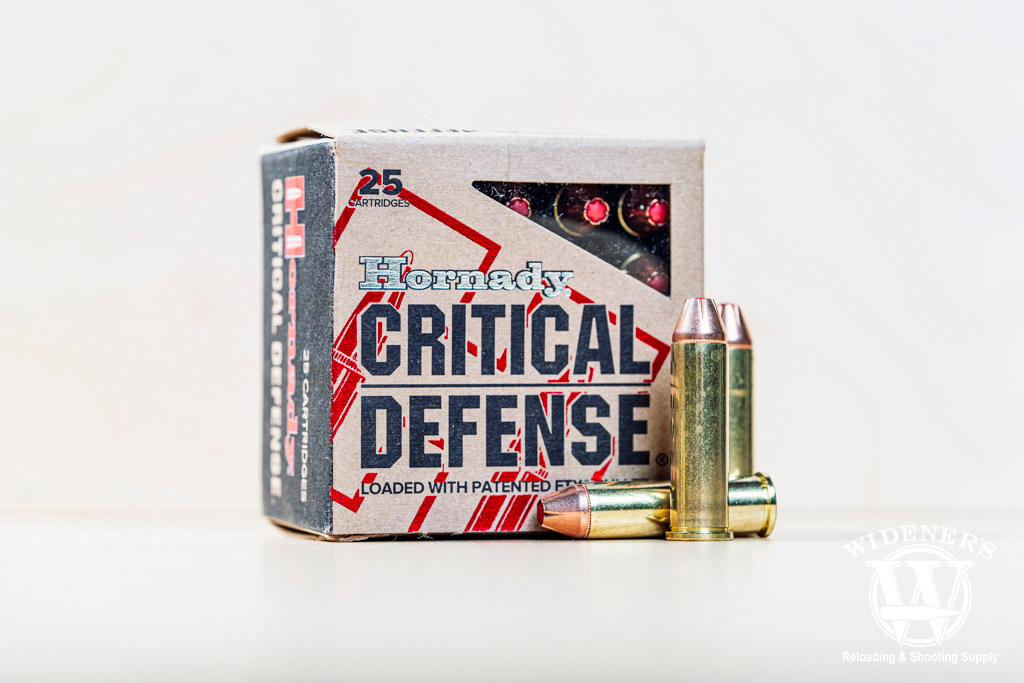
If reliability for concealed carry is your main priority, Hornady’s Critical Defense performance won’t disappoint you.
The .357 magnum is also a popular home and personal defense cartridge. Personally, I prefer something with a higher round capacity, but to each his own.
If you swear by your trusty revolver and want a stout personal defense cartridge, you can’t go wrong with Hornady Critical Defense. Their 125-grain FTX projectiles feature their patented flex tip, which ensures consistent expansion and penetration. The bullet’s design also helps limit overpenetration, which is always a concern in self-defense scenarios. It’s some of the best .357 Magnum ammo around.
The FTX leaves the muzzle at 1,500 FPS and produces 624 foot-pounds of muzzle energy.
| Caliber | Bullet Type | Bullet Weight | Velocity (Muzzle) | Energy (Muzzle) | 25 Yards (Velocity/Energy) | 50 Yards (Velocity/Energy) | 100 Yards (Velocity/Energy) |
|---|---|---|---|---|---|---|---|
| .357 Magnum | FTX | 125gr | 1,500 FPS | 624 FT LBS | 1,404 FPS/547 FT LBS | 1,312 FPS/478 FT LBS | 1,163 FPS/376 FT LBS |
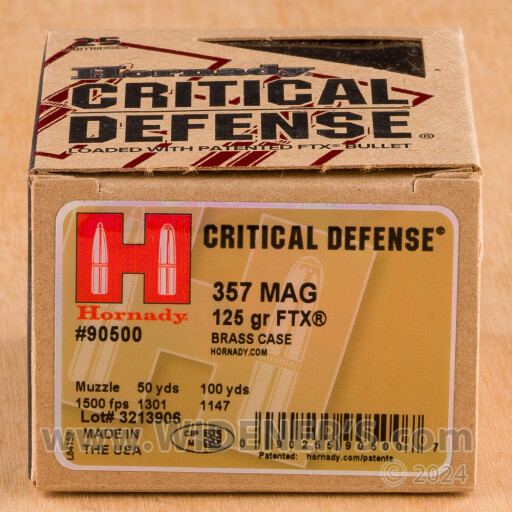
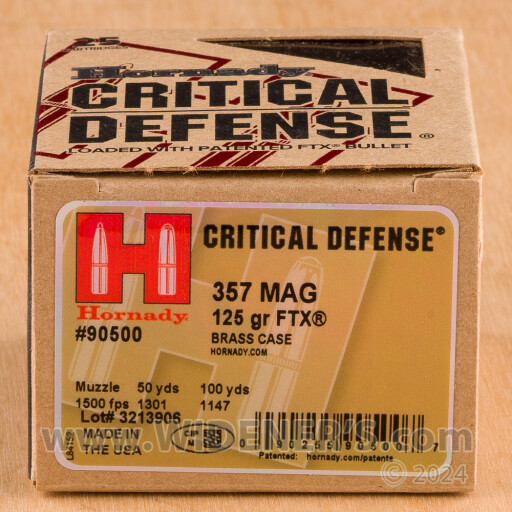
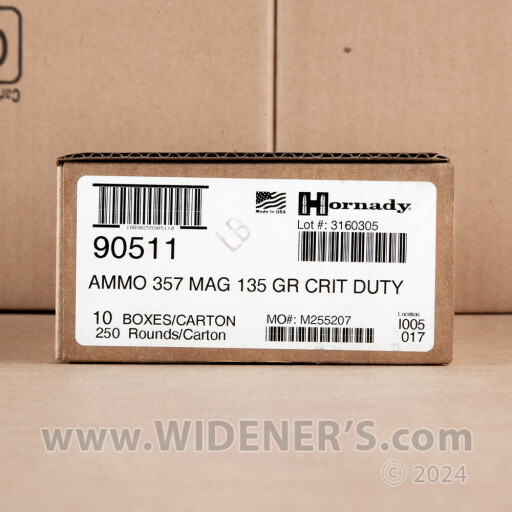
Ballistics Overview
The .357 Magnum’s ballistics are characterized by high velocity, flat trajectory, and potent energy transfer. A typical 125-grain JHP round can reach velocities of up to 1,450 fps, with energy levels around 584 ft-lbs. This performance makes the .357 Mag capable of stopping threats effectively and humanely taking out game within its range.
Cartridge Specs Overview
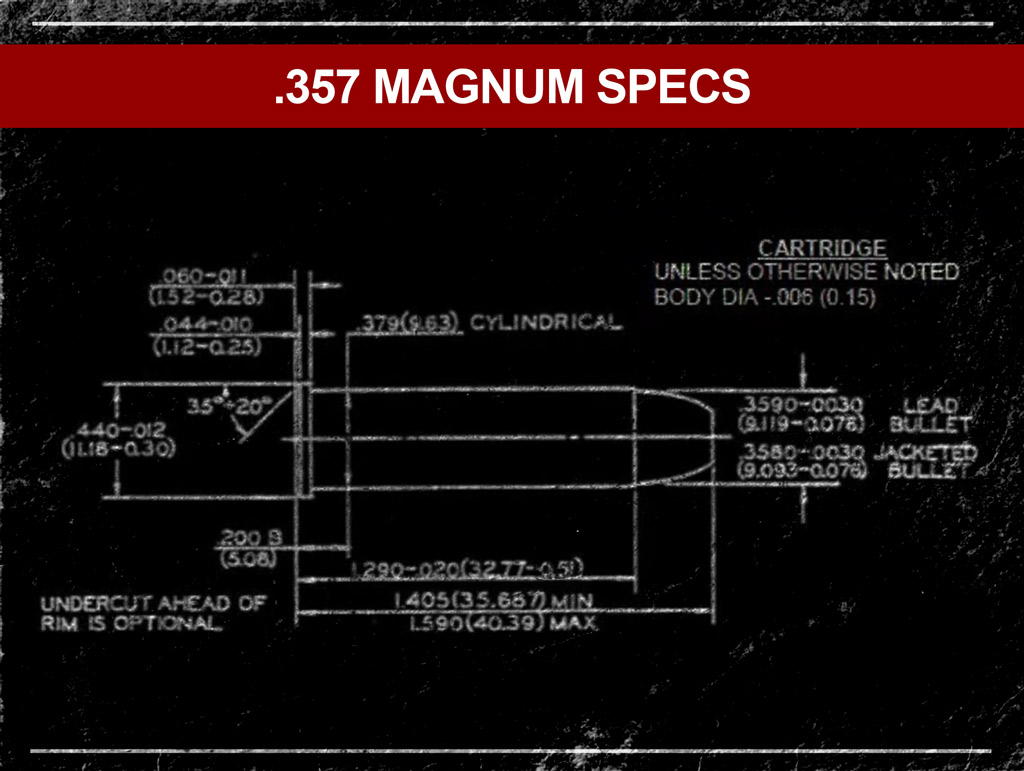
The .357 Magnum overpowers the .38 Special round, despite having almost identical case dimensions.
The .357 Magnum typically uses bullets ranging from 125 to 158 grains, with a case length slightly longer than the .38 Special. This feature prevents it from being chambered in .38 Special firearms. This design ensures safe operation, given the .357’s higher pressure and performance capabilities.
| Cartridge Specs | .357 Magnum |
|---|---|
| Parent Casing | .38 Special |
| Bullet Diameter | .357″ |
| Neck Diameter | .379″ |
| Base Diameter | .379″ |
| Case Length | 1.29″ |
| Overall Length | 1.59″ |
| Grain Weight | 100-200gr |
| Max Pressure (SAMMI) | 35,000 PSI |
The Pros & Cons Of .357 Magnum
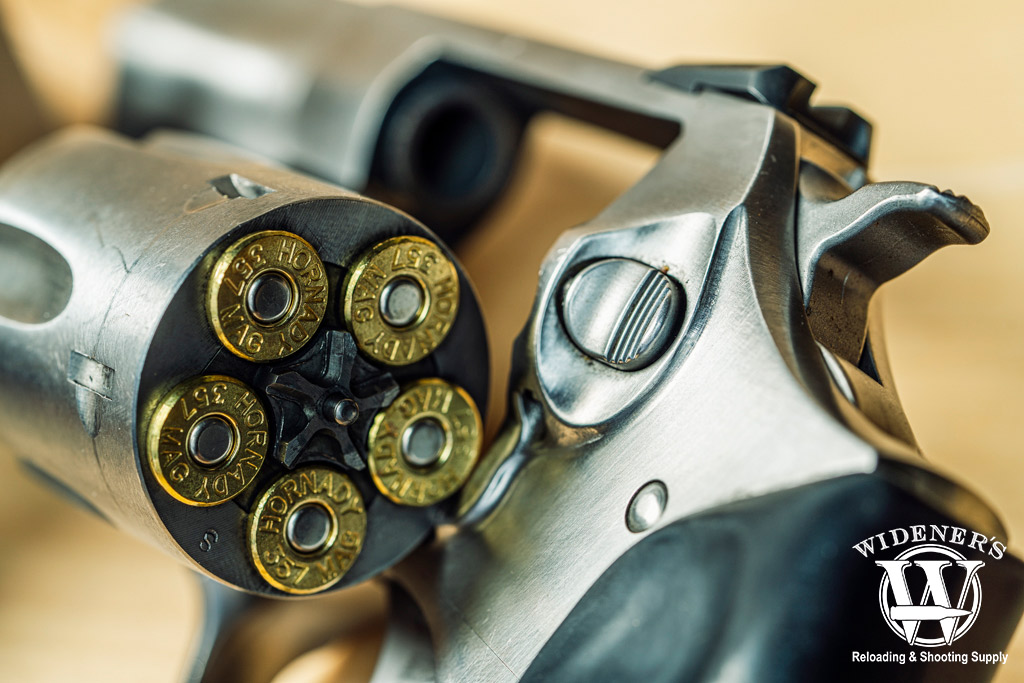
Does it kick? In a handgun .357 Magnum can be a lot to handle. In a rifle? Not too much.
Let’s get into the good and bad of the best .357 magnum ammo.
Pros
Shooters like the .357 magnum because it provides:
- Versatility in use, from self-defense to hunting small and medium game.
- Superior stopping power compared to many handgun calibers.
- A wide variety of ammunition, catering to different shooting needs.
Personally, I like that revolvers chambered in .357 magnum can also accommodate .38 caliber rounds. If I want to spend the day at the range but don’t want to break the bank, I can load up on the cheaper cartridges.
Cons
Like any cartridge, the .357 magnum has some drawbacks
- Recoil can be intense for new shooters, affecting follow-up shot accuracy.
- Overpenetration risk in urban environments, especially with FMJ rounds.
- Generally higher cost of ammunition compared to .38 Special.
The good news is that you can offset some of the recoil issues by purchasing a longer-barrelled revolver. Snub-nosed revolvers tend to be a bit snappier and hard to control. Opting for a revolver with a standard barrel length of 4-6” will promote better controllability.
Best Uses For The Caliber
The .357 Magnum excels in several roles:
- Personal Defense: Its stopping power and reliability make it a top choice for home and personal defense.
- Hunting: Ideal for hunting small to medium game at close to mid ranges.
- Target Shooting/Competition: Its accuracy and variety of available loads make it suitable for recreational shooting and competitive events.
Plus, it’s just fun to shoot. Hitting the range with an old-school revolver chambered in .357 magnum makes for a memorable shooting experience. Even though I don’t use a revolver as my daily carry weapon, I’ll always have at least one of them in my gun safe.
357 Magnum VS 38 Special
The .38 Special and the .357 Magnum have played significant roles in the history of firearms, each with its own unique characteristics, performance capabilities, and applications. The .38 Special, introduced in 1898, has been a staple in law enforcement and personal defense for many decades. Known for its manageable recoil, reliability, and effectiveness at short to medium ranges, the .38 Special is suitable for shooters of all skill levels. Its versatility is further enhanced by the wide variety of ammunition types available, including wadcutter, semi-wadcutter, and jacketed hollow point rounds.
The .357 Magnum, developed in the 1930s, was designed to improve upon the .38 Special by offering greater velocity, energy, and stopping power. This was achieved by lengthening the .38 Special case and loading it to higher pressures, which allowed the .357 Magnum to achieve significantly higher performance levels. The .357 Magnum is capable of handling more diverse shooting scenarios, from self-defense to hunting small and medium game. Its increased power comes with a trade-off, however, as it typically produces more recoil and muzzle blast than the .38 Special.
Ammunition Compatibility
One of the notable advantages of weapons chambered in .357 Magnum is their compatibility with .38 Special ammunition, allowing shooters to practice with the less expensive and lower-recoiling .38 Special rounds while still carrying the more powerful .357 Magnum for defense or hunting. This versatility, combined with the cartridge’s superior ballistics, makes the .357 Magnum a popular choice among those seeking a balance between power and adaptability.
While the .38 Special offers ease of use, lower recoil, and has been trusted for personal defense for many years, the .357 Magnum provides a step up in power and versatility, making it suitable for a broader range of shooting activities. The choice between the two often comes down to the shooter’s specific needs, preferences, and sensitivity to recoil.
Looking Back: .357 Magnum History
The .357 Magnum was introduced in 1934, born from the collaboration between Smith & Wesson and Winchester. It was designed to improve the .38 Special’s velocity and stopping power, addressing the needs of law enforcement agencies for a more potent round. The .357 Mag quickly earned a reputation for its effectiveness in the field, cementing its place in firearm history.
More Bang For Your Buck: The Best .357 Magnum Ammo
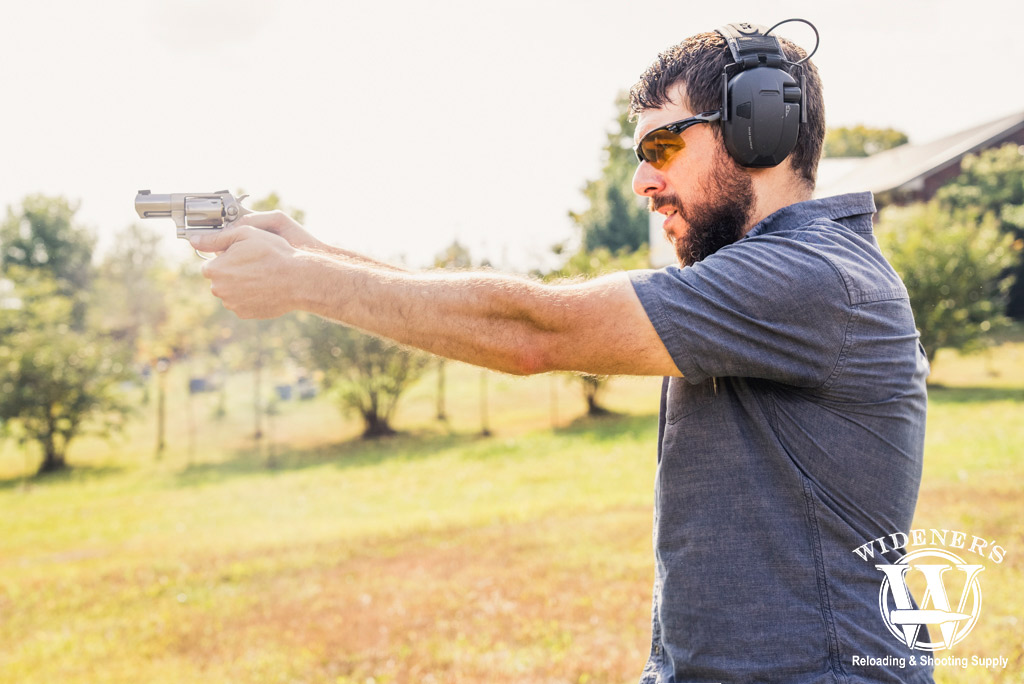
Best 357 Ammo: Dependabity, with good ballistic performance, and a reputation for getting the job done.
The .357 Magnum is a versatile, powerful cartridge that has earned its place in the hearts of shooters worldwide. Its rich history, impressive ballistics, and adaptability make it suitable for a wide range of applications. When selecting .357 Mag ammo, consider your specific needs. Be they training, competition, hunting, or defense—to ensure you get the most out of this iconic caliber.
Whether you’re drawn to the precision of Magtech’s FMJ for training, the authenticity of Black Hills’ Cowboy Load for competition, the terminal performance of Remington’s SJHP for hunting, or the defensive capabilities of Hornady’s Critical Defense, the best .357 Magnum ammo offers options to meet every shooter’s requirements.


